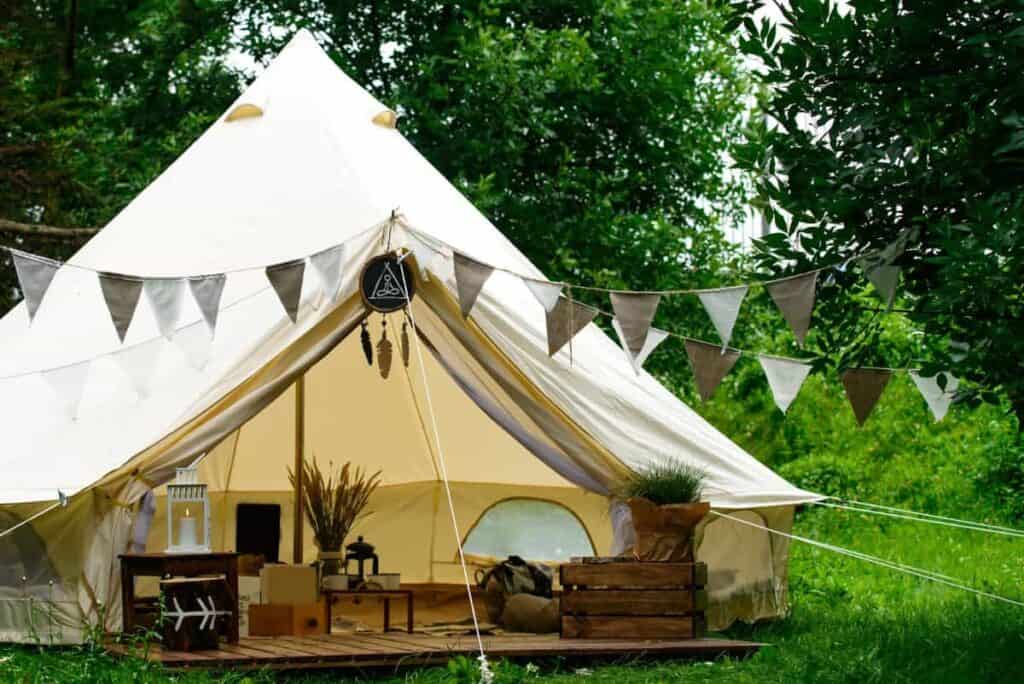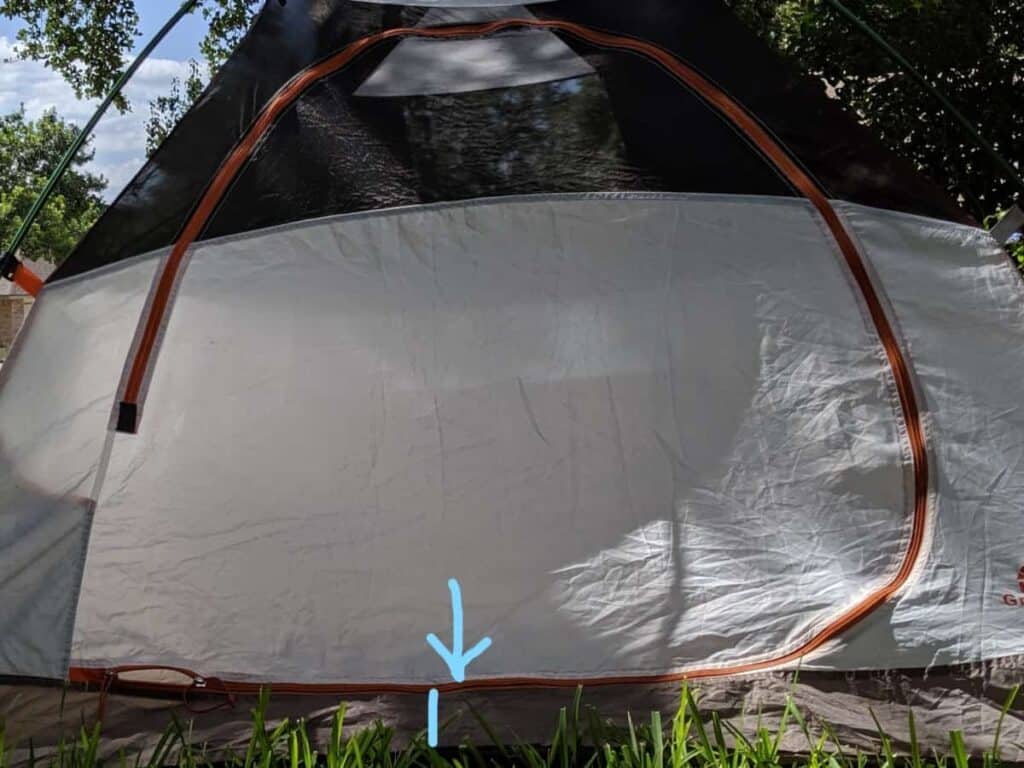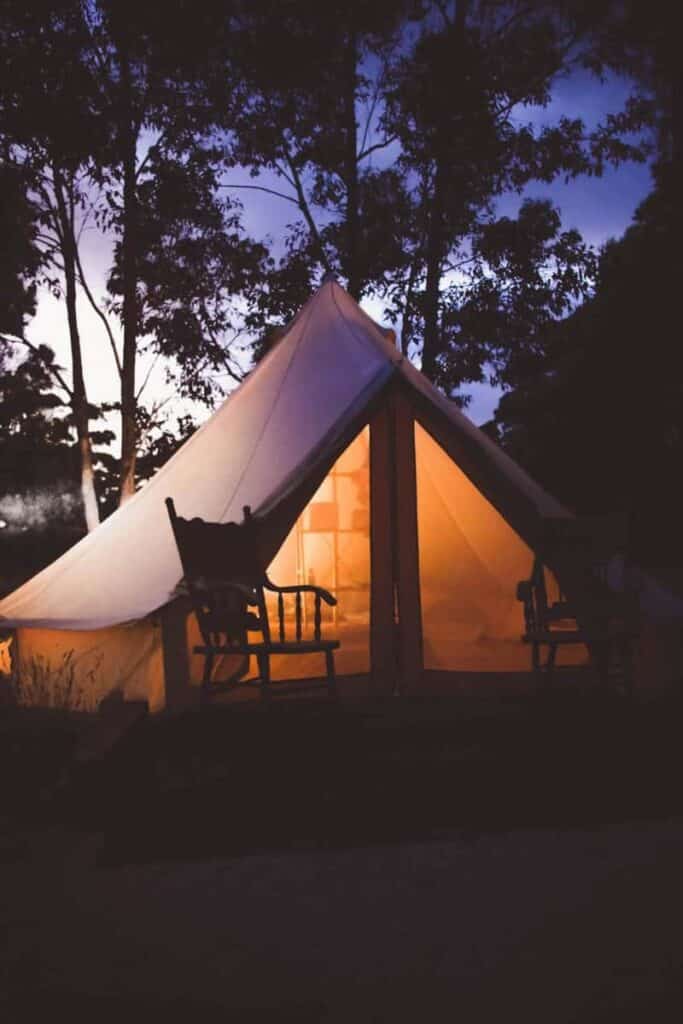So, you’ve heard about canvas tents and you might be wondering about them. Are they outdated? In the past, there really weren’t any other tent options! Tents made out of nylon or other synthetic materials were created to reduce weight, which is a high priority for backpackers. Synthetic tents are by far more popular than canvas tents nowadays, but have we made progress on all fronts because of this?

I didn’t know very much about canvas tents before writing this article so I decided to learn more about canvas tents and their advantages. There are certainly disadvantages to owning and using a canvas tent, but this article is focused on the reasons why you want a canvas tent.
If you are in the market to purchase a tent, I made the Tent Prices Guide explaining how much tent you can get for your money (so you don’t overspend or underspend on your tent). It has some examples of canvas tents there, but I go into more detail of the advantages here.
By the way, as an Amazon Associate, I earn when buying qualified products through links on my site.
This post will dive into 13 compelling reasons why you might want to use a canvas tent instead:
- Sun Protection
- Canvas Tents Stay Cooler
- Canvas Tents Retain Heat
- Canvas Tent Longevity
- Breathability and Condensation
- Sustainability
- Repairable
- Canvas Tent Walls and Sharps
- Heat Resistant–A Stove Inside Your Canvas Tent!
- Accessibility of Wall Tents: Tired of Tripping?
- Ideal for Glamping
- Wind Protection
- Customization Potential
- People Know You’re a Pro When You Show Up with a Canvas Tent
By the way, White Duck Outdoors, a major outfitter for Canvas Tents is having a 25% off sale for this holiday season. If you want to buy a canvas tent, now’s the time.
1. Sun Protection
Canvas is a thicker material than the synthetic materials used in most tents, today. Because of this, less sun gets through to the interior of the tent.
Although it is still important to pick a campsite with as much shade as possible, a canvas tent will offer more sun protection (if needed) than lighter synthetic tents.
Furthermore, if you are a light sleeper and wake up easily when it’s light out–a canvas tent again has the advantage of being a thicker material with less sun exposure, so it will stay dark longer! (depending on how you adjust the windows) You might catch some more Zs with a canvas tent.
Not only do canvas tents protect you from the sun, but because they are made of tougher fabrics, they will last longer in the sun than the thinner synthetic nylon/polyester tents.
Sun damage is one of the easiest ways to ruin your tent. Once a synthetic nylon/poly tent gets significant sun damage, you need to start investing in a new tent. Canvas tents are made to be set up for longer periods of time and can withstand the UV rays from the sun for longer periods of time.
Canvas tents aren’t invincible, of course, and nothing can withstand the sun forever, so it’s still important to camp in shady locations if possible.
2. Canvas Tents Stay Cooler
One amazing thing about modern houses is insulation. We take it for granted! but it’s because of insulation that our houses can stay cooler than the outside heat, or warmer than the outside chill.
Canvas tents are made of thicker, heavier materials. Sometimes they are made of cotton, and other times they are made from synthetic materials or a blend of the two.
In any case, because canvas tents are thicker, they offer more protection from the sun and therefore the inside of a canvas tent can be significantly cooler than a synthetic tent. Now, any tent of any material that is sitting in direct sunlight will eventually heat up to the same temperature, but this could mean you could enjoy your canvas tent in the morning longer than if you had been in a synthetic tent.
Even if the air has had a chance to heat up inside the canvas tent, not having the sun beating down on you will always make the inside cooler and nicer to hang around in.
3. Canvas Tents Retain Heat
The same reason that enabled canvas tents to stay cooler in the summer is the same reason why they can stay warmer than the outside. The heat from the inside is insulated from escaping outside the tent, which makes canvas tents a cozier option than synthetic tents during chilly conditions.
In fact, if you are camping in extreme weather conditions, then you need to use a polar tent. Polar tents are made of thick synthetic materials to trap as much heat as possible. For example, Arctic Oven, a company in Alaska that manufactures extreme weather 4-season tents, makes a 10-person tent that is 42 lbs. The interior looks closer to a lighter synthetic tent, but the tent fly is an extremely thick (200-denier) nylon canvas-like material.
In general, the thicker the fabric, the better the insulation.
AirframesAlaska.com also sells some “arctic-grade” tents that are traditional canvas tents.
4. Canvas Tent Longevity
As we’ve already mentioned, canvas tents are meant for longer periods of camping. If you’re staying in one place for 1 or 2 nights than a lightweight nylon/poly tent is absolutely the way to go. However, if you’re interested in a tent that is made for camping from a week to several weeks at a time, then you should consider a canvas tent as an option.
One of the primary advantages of canvas tents is their durability. They last much longer exposure to sun, wind, and rain, and are much tougher at withstanding the wear and tear that we humans put on our dwellings.
A well taken care of canvas tent (stored completely dry) can last for decades. The longevity of any tent of any material depends on its care. However, simply by the nature of canvas tents with their thick fabric, a canvas tent will outlast thinner synthetic nylon/poly tents.
5. Breathability and Condensation
Synthetic nylon/polyester tents are amazing at retaining heat for how lightweight they are, which is one of the big reasons why people use them. However, this heat retention comes at a cost. Nylon and polyester (two of the primary materials used in synthetic tents) are not breathable. This is why your pure synthetic shirts smell so bad so fast: synthetic materials are not as breathable as cotton.
Having a non-breathable tent promotes one of the biggest enemies of the inside of your tent: Condensation! If it’s humid out, your synthetic tent can become the condensation station, turning your vacation into a cold and clammy destination, or a sweaty and muggy occasion.
Phew, now that that’s out of my system…. let’s move on.
Not all canvas tents are made out of cotton, however, cotton canvas tents have the advantage of being more breathable than synthetic tents.
More breathable tents mean tents less likely to experience condensation. That being said, any surface will condensate if you do not have inadequate ventilation. Make sure you have your tent vented properly to avoid condensation.
6. Sustainability
Cotton is an organic material that is sourced from the fibers from the cotton plant. Cotton is biodegradable, meaning if left in the dirt long enough, it will decompose back into its basic building blocks.

Synthetic materials such as nylon and polyester are derived from petroleum–a non-renewable resource. Synthetic materials, unfortunately, are not considered biodegradable, and the fabric of a synthetic tent might take decades to decay, rather than months for cotton tents.
Remember, not all canvas tents are made out of cotton–several are blended with synthetic materials to make them more rot-resistant.
7. Repairable
Many tent rips and tears are repairable, even for nylon/polyester tents. However, sometimes synthetic nylon/polyester tents can reach a point where the damage is extensive and not worth the effort in fixing.
For example, if your synthetic tent has sun damage, then repairing your tent can become a lot more difficult and even unfeasible.
Canvas tents, on the other hand, can be repaired more thoroughly and sustain many more patches than a nylon/poly tent. If there are large sections of your tent that are damaged, you can often use other sections of canvas to replace or supplement them, and then using waterproofing treatment to seal all seams or edges.
Because canvas tents cost more than nylon/polyester backpacking tents, it pays to invest the time and money to repair your tent rather than replacing it. Fortunately, because the canvas is tough and can be patched many times, you will undoubtedly get more time out of your canvas tent than any other type of tent (as long as you take care of it).
8. Canvas Tent Walls and Sharps
Speaking of rips and tears, one huge advantage that canvas has over synthetic nylon/poly tents is its ability to withstand sharps.
This doesn’t mean you should use your canvas tent for archery practice. It has limits!
While camping there are all sorts of ways to rip your tent–pokes from rocks, sticks, and branches, or pulls from shoes, setting up and taking down, and even simply sleeping in your tent and moving around all exert twisting forces to your tent fabric. Canvas tents are made from thicker materials which can withstand all of those pressures better than the thinner nylon/poly tents.
9. Heat Resistant–A Stove Inside Your Canvas Tent!
Canvas tents are not fireproof. But, they can withstand much higher temperatures. In fact, many different canvas tents are specifically built to allow stoves!
This is just not a reality for nylon/polyester backpacking tents. The fabric is so thin that any exposure to heat to this degree would shrink and warp the tent, damaging the fabric permanently. Canvas tents have the advantage of being more heat resistant.
In fact, they are so heat resistant, that many of them come with stove jacks, which are basically little portholes for chimneys for small stoves.
Examples of Canvas Tents With Stoves
You can actually cook in your canvas tent. See this wall tent from Montana canvas, and the Sibley 500 deluxe from canvascamp.com, or this Regata Bell tent which has a 5″ stove jack available on whiteduckoutdoors.com
Dangers of Fire Near Canvas
Even though many canvas tents have stove jacks and are made for stoves, care must be taken since cotton canvas still can be ignited in temperatures around 400 degrees Fahrenheit. If there is any kind of oil stain on your canvas than that ignition point can drop in half. Make sure you follow the manufacturer guidelines exactly to distance your stove from the walls correctly.
10. Accessibility of Wall Tents: Tired of Tripping?
Wall Canvas Tents are set up by a frame from steel or aluminum poles, which the tent is then attached to. One of the coolest features of wall canvas tents is that many of them have doorways that go all the way to the ground. Humor me for a second–I’ll explain.
A synthetic lightweight nylon/poly tent usually has a zipper in a large D shape, leaving a big margin of tent fabric between the ground and the entrance to the tent.

Many canvas tents have entrances very similar to this, but wall canvas tents differ in that the floor of the tent is not attached to the wall. Instead, the floor of tent is laid out separately.
This particular feature of a wall tent (the walls not being connected to the floor) makes these tents ideal for lots of foot traffic because there is no longer a tiny ledge to trip over! I wish I could tell you that because I’m an adult that I am coordinated enough to never trip over the entrance in my tent… but I can’t. Wall canvas tents feel more like a tiny house than a tent and are easy to enter and exit.
Wall tent manufacturers are smart though–they still will install mesh nets for bugs so you can have your door open but still have protection from insects.
11. Ideal for Glamping
How often do you see those stunning glamping pictures of tents with queen-sized beds complete with foam mattresses in the synthetic nylon/polyester tents?
Never!

The durability and size of canvas tents make these tents ideal for holding furniture, beds, rugs, and other amenities common in glamping that would not be possible with the synthetic nylon/poly tents.
Canvas tents can even work with semi-permanent flooring. A tent with wood floors is much more memorable than a tent with a simple canvas floor (or dirt).
12. Wind Protection
If you’ve ever been in a thin backpacking synthetic nylon/poly tent during a windstorm, then you know that sinking feeling when the wind is flapping your tent like crazy and you’re almost positive that you will be whisked away to Oz. A lot can be done to protect your thin synthetic tent from the wind, such as windscreens, location selection, and guying out your tent properly, but the strength and weight of the fabric also have a lot to do with the stability of the tent.
Canvas tents offer superior stability in high wind conditions. It’s still crucially important to make sure you’ve guyed out your tent and selected a good location, but your canvas tent won’t flap around as much inspiring thoughts of the Wizard of Oz and scarecrows and the like.
13. Customization Potential
Another super cool feature relating to canvas tents is that since they are often made to order, they are also capable of being customized!
Montana Tents, for example, allows you to build custom tents and select the following:
- The thickness and type of canvas
- The dimensions of the tent
- The size of the windows
- The type of door entrance
Canvas tent manufacturers often give you the flexibility to build the tent you want to meet the exact needs you’re looking for.
Davis tent manufacturers give even more options. If a tent with the exact specifications you want is important to you, a canvas tent is the way to go!
14. People Know You’re a Pro When You Show Up with a Canvas Tent
Lastly, one really fun reason for getting a canvas tent is the wow factor. This isn’t really a quantifiable advantage, but there definitely is notoriety associated with canvas tents. They are just cool, even by themselves. Some have a rustic feel to them, and for glamping, they give off an air of comfort and solidarity.

